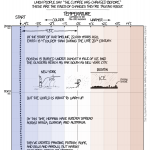Language phylogeny
This is a great cartoon by Randall Munroe that makes a very important point very effectively. Spread it around, love it, learn from it.
Here is an excellent video walkthrough of the cartoon, discussing its value as a communication tool.
But do ignore the details of the prehistory because the cartoonist has fallen into the same trap so many others have, well meaning in intention but simply a) not an expert on key things and b) unaware of the real consequences of getting certain things wrong.
When we represent prehistory, we represent humanity both past and present. It is not difficult to do…
... of English:
The nomenclature for the US accents is wildly incorrect, but these are good renditions of something.
I recently posted about the work by Pagel and colleagues regarding ancient lexicons. That work, recently revived in the press for whatever reasons such things happen, is the same project reported a while back in Nature. And, as I recall, I read that paper and promised to blog about it but did not get to it. Yet.
So here we go.
The tail does not wag the dog
The primary finding of the Pagel et al. study is this: When comparing lexicons from different languages, meanings that shared a common word in an ancestral language change over time more slowly if the word in question is used more…
And with this, a five year old catapulted back in time, say 10,000 years in West Asia or Southern Europe, encountering two people, would make perfectly intelligible sentence that wold be understood by all. Assuming all the people who were listening were at least reasonably savvy about language and a little patient. This is because a handful of words, including Who, You, Two, Five, Three and I exist across a range of languages as close cognates, and can be reconstructed as similar ancestral utterances in ancestral languages.
It's like an elephant and a mammoth meeting up in the Twilight…
